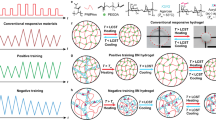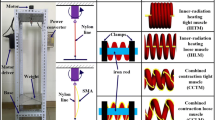Abstract
Thermo-responsive shape memory hydrogels generally achieve shape fixation at low temperatures, and shape recovery at high temperatures. However, these hydro-gels usually suffer from poor mechanical properties. Herein, we present a unique poly(acrylic acid)/calcium acetate shape memory hydrogel with cold-induced shape recovery performances as ultrastrong artificial muscles. Since the acetate groups could form aggregate at high temperatures and thus induce the association of the hydrogel network, the hydrogel can be fixed into a temporary shape upon heating and recover to its original shape in a cold environment. Moreover, a programmable shape recovery process is realized by adjusting the shape fixing time. In addition, the unique shape memory process enables the application demonstration as bio-inspired artificial muscles with an ultrahigh work density of 45.2 kJ m−3, higher than that of biological muscles (∼8 kJ m−3).
摘要
热致响应形状记忆水凝胶通常在低温时固定临时形状, 升高温度回复至初始形状. 然而, 水凝胶高含水量的特点导致其较弱的力学性能, 限制了其广泛应用. 本文介绍了一种具有独特的冷致形状回复功能的聚丙烯酸/乙酸钙水凝胶, 由于乙酸基团在高温下形成聚集体, 进而会导致聚丙烯酸网络的疏水聚集和硬化, 因而水凝胶的临时形状可在70°C时固定, 并在20°C的低温环境回复至初始形状. 同时, 通过调控形状固定时间可以实现分步形状恢复. 这种形状记忆水凝胶可用作人工肌肉, 其做功能力高达45.2 kJ m−3, 远超过一般动物肌肉的做功能力(∼8 kJ m−3).
Similar content being viewed by others
References
Zhao Q, Qi HJ, Xie T. Recent progress in shape memory polymer: New behavior, enabling materials, and mechanistic understanding. Prog Polym Sci, 2015, 49–50: 79–120
Lendlein A, Gould OEC. Reprogrammable recovery and actuation behaviour of shape-memory polymers. Nat Rev Mater, 2019, 4: 116–133
Wang K, Jia YG, Zhao C, et al. Multiple and two-way reversible shape memory polymers: Design strategies and applications. Prog Mater Sci, 2019, 105: 100572
Zhang D, Zhang J, Jian Y, et al. Multi-field synergy manipulating soft polymeric hydrogel transformers. Adv Intelligent Syst, 2021, 3: 2000208
Zhuo S, Zhao Z, Xie Z, et al. Complex multiphase organohydrogels with programmable mechanics toward adaptive soft-matter machines. Sci Adv, 2020, 6: 1464
Zhu CN, Bai T, Wang H, et al. Dual-encryption in a shape-memory hydrogel with tunable fluorescence and reconfigurable architecture. Adv Mater, 2021, 33: 2102023
Xie T. Tunable polymer multi-shape memory effect. Nature, 2010, 464: 267–270
Julich-Gruner KK, Löwenberg C, Neffe AT, et al. Recent trends in the chemistry of shape-memory polymers. Macromol Chem Phys, 2013, 214: 527–536
Xu W, Zhang R, Liu W, et al. A multiscale investigation on the mechanism of shape recovery for IPDI to PPDI hard segment substitution in polyurethane. Macromolecules, 2016, 49: 5931–5944
Xu XQ, He Y, Liu H, et al. Polydiacetylene-polyurethane crisscross elastomer as an intrinsic shape memory conductive polymer. ACS Macro Lett, 2019, 8: 409–413
Osada Y, Matsuda A. Shape memory in hydrogels. Nature, 1995, 376: 219
Lei H, Dong L, Li Y, et al. Stretchable hydrogels with low hysteresis and anti-fatigue fracture based on polyprotein cross-linkers. Nat Commun, 2020, 11: 4032
Kempaiah R, Nie Z. From nature to synthetic systems: Shape transformation in soft materials. J Mater Chem B, 2014, 2: 2357–2368
Liu T, Wang F, Wu Q, et al. Fluorescent, electrically responsive and ultratough self-healing hydrogels via bioinspired all-in-one hierarchical micelles. Mater Horiz, 2021, 8: 3096–3104
Xu H, Shi FK, Liu XY, et al. How can multi-bond network hydrogels dissipate energy more effectively: An investigation on the relationship between network structure and properties. Soft Matter, 2020, 16: 4407–4413
Dou Y, Wang ZP, He W, et al. Artificial spider silk from ion-doped and twisted core-sheath hydrogel fibres. Nat Commun, 2019, 10: 5293
Li X, He L, Li Y, et al. Healable, degradable, and conductive MXene nanocomposite hydrogel for multifunctional epidermal sensors. ACS Nano, 2021, 15: 7765–7773
Zhang S, Li Y, Zhang H, et al. Bioinspired conductive hydrogel with ultrahigh toughness and stable antiswelling properties for articular cartilage replacement. ACS Mater Lett, 2021, 3: 807–814
Li X, Wang Z, Li W, et al. Superstrong water-based supramolecular adhesives derived from poly(vinyl alcohol)/poly(acrylic acid) complexes. ACS Mater Lett, 2021, 3: 875–882
Ju G, Cheng M, Guo F, et al. Elasticity-dependent fast underwater adhesion demonstrated by macroscopic supramolecular assembly. Angew Chem Int Ed, 2018, 57: 8963–8967
Zhu J, Chen GY, Yu L, et al. Mechanically strong and highly stiff supramolecular polymer composites repairable at ambient conditions. CCS Chem, 2020, 2: 280–292
Li P, Xia Y, Hao J, et al. Transient healability of metallosupramolecular polymer networks mediated by kinetic control of competing chemical reactions. Macromolecules, 2020, 53: 2856–2863
Le X, Lu W, Zheng J, et al. Stretchable supramolecular hydrogels with triple shape memory effect. Chem Sci, 2016, 7: 6715–6720
Li P, Wang Z, Lin X, et al. Muscle-inspired ion-sensitive hydrogels with highly tunable mechanical performance for versatile industrial applications. Sci China Mater, 2022, 65: 229–236
Xu L, Qiu D. Reversible switching of polymeric gel structure and property by solvent exchange. Sci China Mater, 2022, 65: 547–552
Xie M, Wu C, Chen C, et al. Photo-adaptable shape memory hydrogels based on orthogonal supramolecular interactions. Polym Chem, 2019, 10: 4852–4858
Jia YG, Jin J, Liu S, et al. Self-healing hydrogels of low molecular weight poly(vinyl alcohol) assembled by host-guest recognition. Biomacromolecules, 2018, 19: 626–632
Xiao H, Lu W, Le X, et al. A multi-responsive hydrogel with a triple shape memory effect based on reversible switches. Chem Commun, 2016, 52: 13292–13295
Hu X, Zhang D, Sheiko SS. Cooling-triggered shapeshifting hydrogels with multi-shape memory performance. Adv Mater, 2018, 30: 1707461
Zhang Y, Desai MS, Wang T, et al. Elastin-based thermoresponsive shape-memory hydrogels. Biomacromolecules, 2020, 21: 1149–1156
Nonoyama T, Lee YW, Ota K, et al. Instant thermal switching from soft hydrogel to rigid plastics inspired by thermophile proteins. Adv Mater, 2020, 32: 1905878
Zhao C, Ma Z, Zhu XX. Rational design of thermoresponsive polymers in aqueous solutions: A thermodynamics map. Prog Polym Sci, 2019, 90: 269–291
Kram R. Inexpensive load carrying by rhinoceros beetles. J Exp Biol, 1996, 199: 609–612
Lumsden JS. XXXIV.—Solubilities of the calcium salts of the acids of the acetic series. J Chem Soc Trans, 1902, 81: 350–362
Wang L, Jian Y, Le X, et al. Actuating and memorizing bilayer hydrogels for a self-deformed shape memory function. Chem Commun, 2018, 54: 1229–1232
Xue P, Bisoyi HK, Chen Y, et al. Near-infrared light-driven shape-morphing of programmable anisotropic hydrogels enabled by MXene nanosheets. Angew Chem Int Ed, 2021, 60: 3390–3396
Mirfakhrai T, Madden JDW, Baughman RH. Polymer artificial muscles. Mater Today, 2007, 10: 30–38
Ma Y, Hua M, Wu S, et al. Bioinspired high-power-density strong contractile hydrogel by programmable elastic recoil. Sci Adv, 2020, 6: 2520
Acknowledgements
This work was supported by the National Natural Science Foundation of China (51873223 and 22075154) and the Natural Science Foundation of Zhejiang Province (LY19B040001).
Author information
Authors and Affiliations
Contributions
Author contributions Hua L conducted most of the experiments and drafted the manuscript; Zhao C designed the experiments and drafted the manuscript; Guan X helped with the synthesis of the hydrogel; Lu J conducted the rheology experiments; Zhang J initiated and guided the work and drafted the manuscript. All authors contributed to the discussion and preparation of the manuscript.
Corresponding author
Ethics declarations
Conflict of interest The authors declare that they have no conflict of interest.
Additional information
Supplementary information Experimental details and supporting data are available in the online version of the paper.
Luqin Hua received her BSc degree from Ningbo University in 2020. She is now a master candidate at Ningbo University under the supervision of Prof. Chuanzhuang Zhao. Her research interest focuses on shape memory hydrogels and their applications.
Chuanzhuang Zhao received his PhD degree in polymer chemistry and physics from Nankai University in China in 2010. After postdoctoral training at the Institute of Chemistry, Chinese Academy of Sciences, he joined Ningbo University in 2013, and now he is an associate professor. His current research involves the synthetic chemistry and physical chemistry of stimuli-responsive polymers.
Jiawei Zhang received her PhD degree in polymer chemistry and physics from Nankai University in China in 2010, during which she had research training at the University of Montreal (2007–2009, Canada). After postdoctoral training at Tsinghua University, China, she joined Ningbo Institute of Materials Technology and Engineering, Chinese Academy of Sciences in 2013, and now she is a professor of Tiangong University. Her research interest includes smart polymeric hydrogel actuators and shape memory hydrogels.
Supporting information for
Rights and permissions
About this article
Cite this article
Hua, L., Zhao, C., Guan, X. et al. Cold-induced shape memory hydrogels for strong and programmable artificial muscles. Sci. China Mater. 65, 2274–2280 (2022). https://doi.org/10.1007/s40843-021-1971-9
Received:
Accepted:
Published:
Issue Date:
DOI: https://doi.org/10.1007/s40843-021-1971-9




